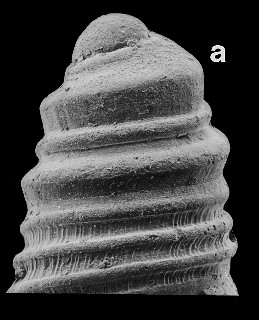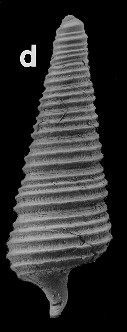
Revised descriptions of New Zealand Cenozoic Mollusca from Beu and Maxwell (1990)

 | Revised descriptions of New Zealand Cenozoic Mollusca from Beu and Maxwell (1990) | 
|
  (Pl. 55a): Seila (Lyroseila) cincta (Hutton, 1886) (type species (as its synonym S. chathamensis Suter, 1908) of Lyroseila Finlay, 1926 (see Marshall 1978, p. 96–97)); GS14430, Y14/f7505I, Te Piki, near East Cape (Haweran) (apex showing strongly keeled protoconch and axial ridges between spiral cords on teleoconcha). |
  (Pl. 55d): Seila (Lyroseila) cincta (Hutton, 1886) (type species (as its synonym S. chathamensis Suter, 1908) of Lyroseila Finlay, 1926 (see Marshall 1978, p. 96–97)); GS14430, Y14/f7505I, Te Piki, near East Cape (Haweran) |
Beu & Maxwell (1990): Chapter 17; p. 382; pl. 55 a,d.
Classification: Cerithiopsidae: Cerithiopsinae
Description: Height c. 2.5-9 mm, moderately attenuate, spire straight- sided or slightly cyrtoconoid (i.e. with convex outline). Protoconch large, broadly conical, of 2-3 whorls, with prominent spiral keel or median angulation, some species with weak spiral lirae or threads, others smooth. Teleoconch whorls weakly convex, spire whorls with 3 prominent, subequal cords, some species with additional cords appearing during growth, base with 1 or 2 additional cords in some species, smooth in others. Axial sculpture of fine growth ridges or lamellae only. Aperture small, subquadrate, siphonal canal very short, open, weakly deflected to left.
Comparison: Although the Cerithiopsidae is one of the most speciose groups of gastropods recorded from the New Zealand Cenozoic fauna, only a handful of fossil species have been described, and many of these are of uncertain affinities. A major problem in identifying fossil cerithiopsids is that most specimens lack the protoconch. This usually makes generic assignment very difficult, if not impossible, as many species have a very conservative teleoconch sculptural plan. In Seila and related taxa, axial sculpture is only weakly developed and consists of fine growth ridges or lamellae between the well developed spiral cords, but in the majority of other New Zealand species axial and spiral elements are of similar strength, intersecting to form either an open reticulate or clathrate pattern, or rows of small, closely spaced gemmules. Experience has shown that some (apparently sympatric) species may have radically different protoconchs, yet differ only subtly in teleoconch characters.
Marshall (1978) has reviewed the modern New Zealand cerithiopsid fauna, and has demonstrated the great value of protoconch characters in the classification of the family. Unfortunately, no similar study has yet been made on the very numerous fossil species, most of which do not seem to have close relatives in the Recent fauna.
Distribution: Nukumaruan-Recent, New Zealand; Recent, South Australia.
Cite this publication as: "A.G. Beu and J.I. Raine (2009). Revised
descriptions of New Zealand Cenozoic Mollusca from Beu and Maxwell (1990). GNS
Science miscellaneous series no. 27."
© GNS Science, 2009
ISBN
978-0-478-19705-1
ISSN 1177-2441
(Included with a PDF facsimile file
copy of New Zealand Geological Survey Paleontological Bulletin 58 in CD version
from: Publications Officer, GNS Science, P.O. Box 30368 Lower Hutt, New
Zealand)